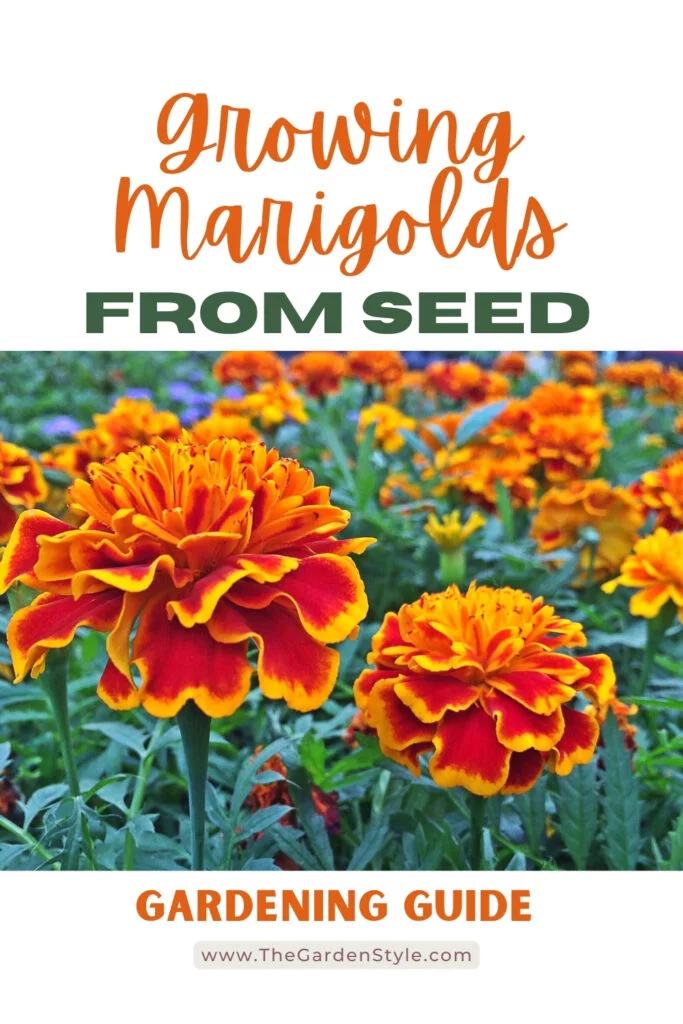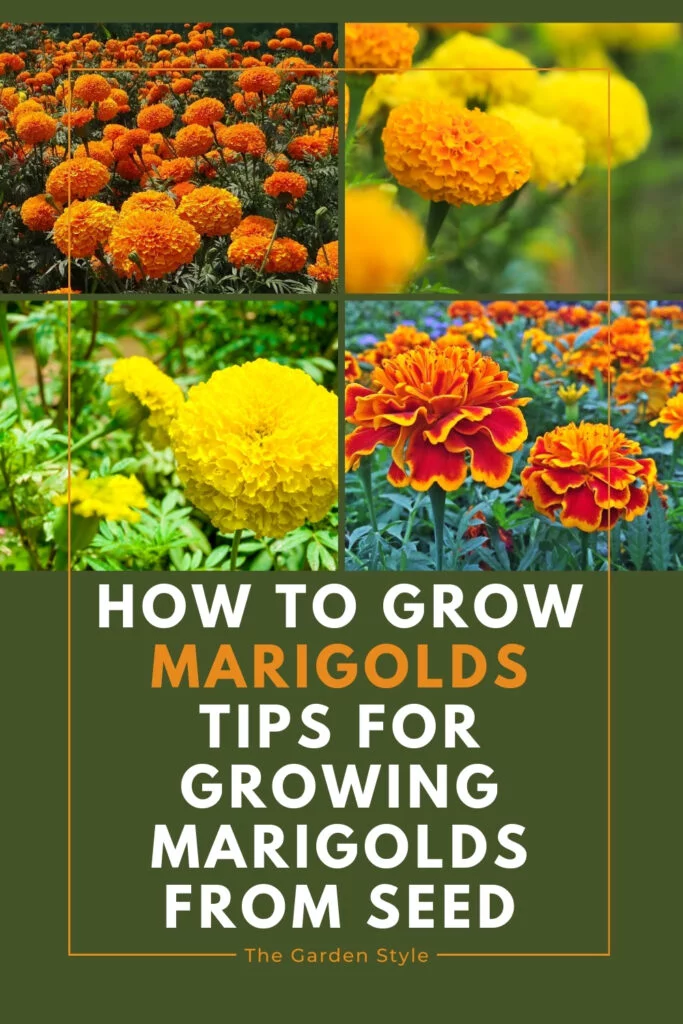Marigolds, with their vibrant colors and easy-going nature, are a favorite among gardeners of all levels. Whether you’re a seasoned pro or just starting out, learning how to grow marigolds can add a splash of sunshine to your garden. In this comprehensive guide, we’ll explore everything you need to know to cultivate these beautiful flowers successfully.
Table of Contents
When to Grow Marigolds?
Marigolds thrive in warm weather, so it’s essential to plant them after the last frost has passed. In most regions, this means planting them in the spring once the soil has warmed up. However, you can also sow seeds in the summer for a late-season bloom.
Marigolds prefer full sun, so select a spot in your garden that receives at least 6-8 hours of direct sunlight per day. They can tolerate a variety of soil types but prefer well-drained, moderately fertile soil.
Common Marigold Varieties
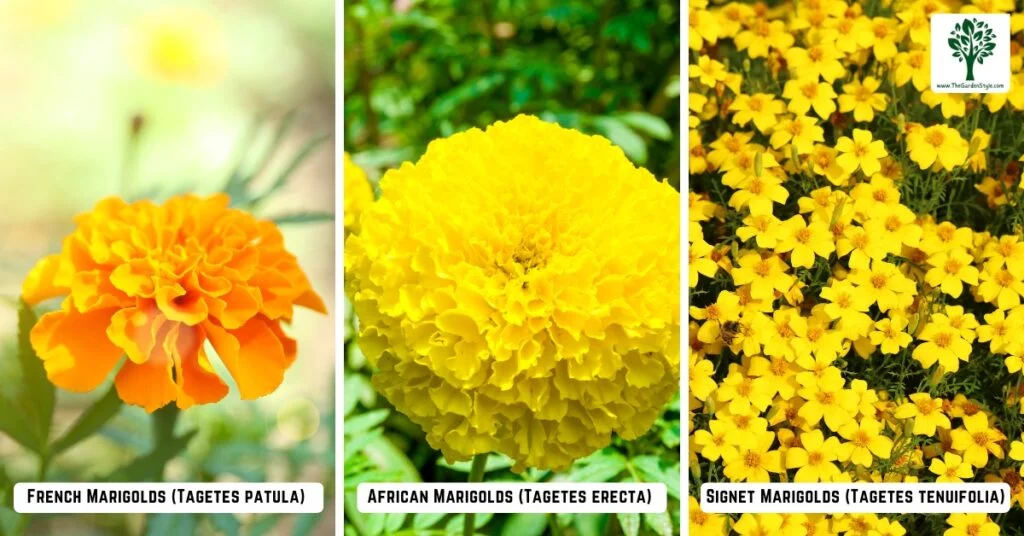
Marigolds come in a variety of shapes, sizes, and colors, offering gardeners plenty of options to choose from. Some of the most common varieties include:
- French Marigolds (Tagetes patula): These compact plants produce small flowers, typically 1-2 inches across, in shades of yellow, orange, and red. French marigolds are prolific bloomers, continuously producing new flowers throughout the growing season.
- African Marigolds (Tagetes erecta): Known for their larger, pom-pom-like flowers, African marigolds have blooms that can measure 2-5 inches across. They come in shades of yellow, orange, and white. African marigolds have a more pronounced flowering period, with a flush of blooms in mid-summer that can last until the first frost.
- Signet Marigolds (Tagetes tenuifolia): These unique marigolds have small, single flowers, usually 1-2 inches wide, in shades of yellow, orange, and red. Their fern-like foliage adds an airy texture to the plant. Signet marigolds are continuous bloomers, producing flowers throughout the growing season.
| Variety | Flower Size | Blooming Habit |
| French Marigolds (Tagetes patula) | Small, 1-2 inches across | Prolific, continuous blooming throughout the season |
| African Marigolds (Tagetes erecta) | Large, pom-pom-like, 2-5 inches across | Pronounced flowering period, mid-summer flush until first frost |
| Signet Marigolds (Tagetes tenuifolia) | Small, single, 1-2 inches wide | Continuous blooming throughout the growing season |
- Get more for your money: This is a beautiful mix of 3 types of marigold flower seeds. Includes a blend of Dainty Marietta French, Petite French, and Sparky French. This is 18 grams over 5600 seeds!
How to Grow Marigolds from Seed
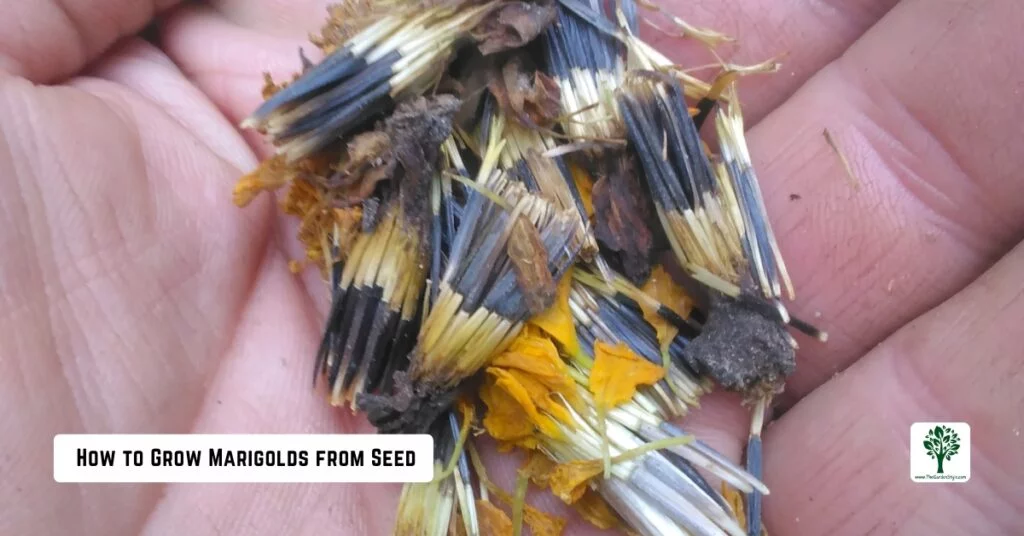
You can grow marigolds from seeds or transplant seedlings purchased from a nursery. Both methods have their pros and cons, so choose the one that best suits your gardening style and schedule.
Marigolds thrive in well-draining, nutrient-rich soil. Before planting, enrich your garden bed with organic amendments such as nutrient-rich compost, aged manure, or fish emulsion to enhance soil fertility and improve drainage. These organic materials provide essential nutrients for healthy marigold growth while ensuring optimal soil structure for robust root development. Marigolds prefer slightly acidic to neutral soil with a pH range of 6.0 to 7.5. Learn how to measure soil pH.
Sowing seeds directly in the garden is a convenient and cost-effective option. Follow these steps:
- After the last expected frost, prepare the soil by loosening it and removing any debris or weeds.
- Sow the seeds about 1/4 inch deep and 6 to 12 inches apart, depending on the variety.
- Water the soil gently and keep it moist until the seeds germinate, which typically takes 5 to 10 days.
- Once the seedlings emerge, thin them out to their recommended spacing.
If you prefer a head start, you can start marigold seeds indoors 4 to 6 weeks before the last expected frost. Transplant the seedlings outdoors after hardening them off for a week or two. Follow these steps:
- Dig holes slightly larger than the seedlings’ root balls, spacing them according to the variety’s recommended distance.
- Carefully remove the seedlings from their containers and place them in the prepared holes.
- Backfill the holes with soil and gently firm it around the plants.
- Water the transplants thoroughly and continue to water regularly until they’re established.
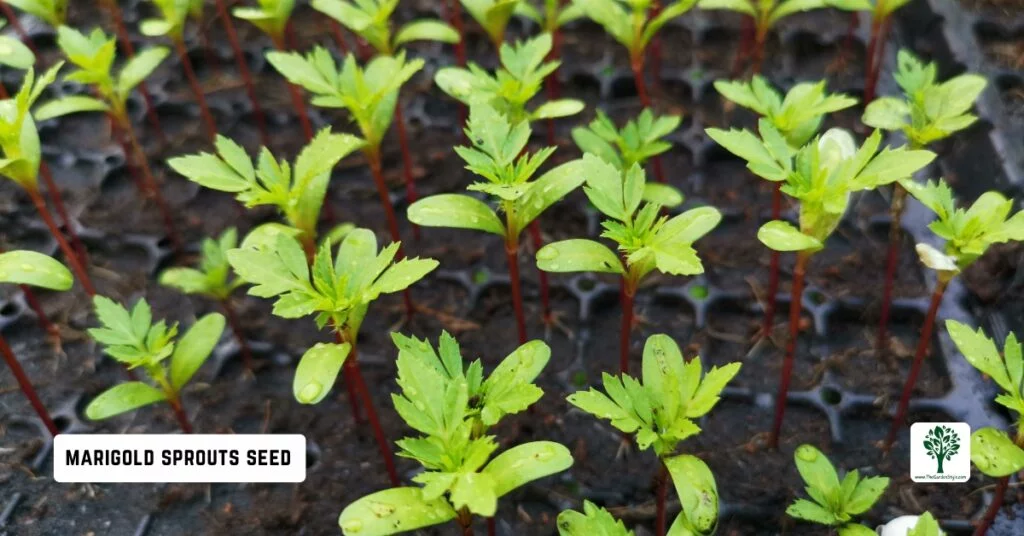
Pinching Marigolds
In addition to deadheading, pinching off the tips of marigold plants can encourage bushier, more compact growth and increased branching. This technique is particularly useful for taller marigold varieties that may become leggy or top-heavy.
To pinch off marigolds, follow these steps:
- When the plants are about 6 to 8 inches tall, use your fingers or pruners to pinch off or snip the growing tip of each main stem.
- Remove about 1 to 2 inches of the stem, just above a set of healthy leaves.
- Pinching should be done early in the growing season, typically 4 to 6 weeks after transplanting or when the plants have developed several sets of leaves.
- Repeat the pinching process every 2 to 3 weeks if you want to maintain a compact, bushy shape.
Pinching encourages the plant to produce more side shoots and lateral branches, resulting in a fuller, more robust plant with more blooms. It also helps prevent marigolds from becoming too tall and leggy, which can cause them to flop over or break under their weight.
However, it’s essential to stop pinching back marigolds about 6 to 8 weeks before the first expected frost in your area. This allows the plants to focus their energy on producing flowers rather than new vegetative growth.
Caring for Marigolds
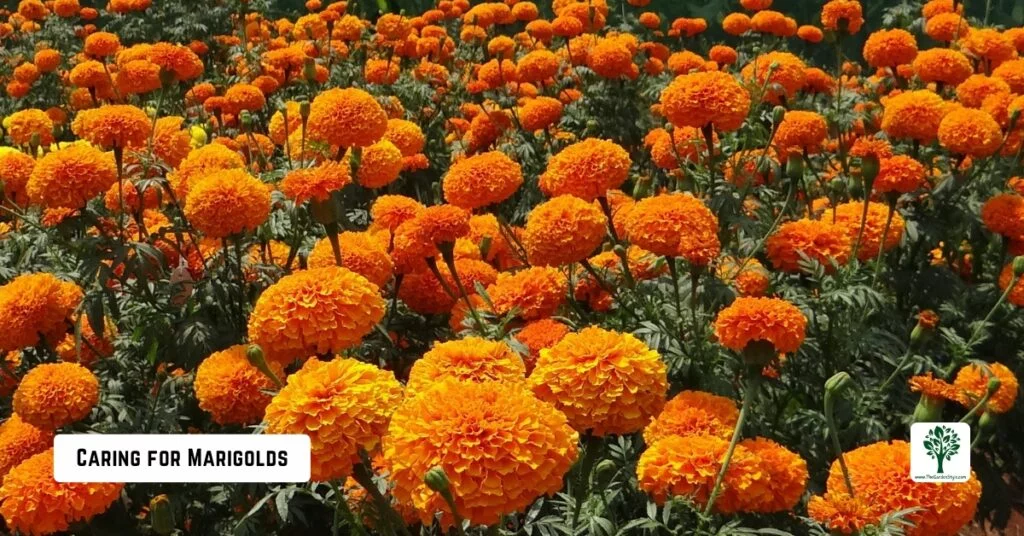
While marigolds are generally low-maintenance plants, providing them with the proper care is crucial for ensuring their vibrant blooms and overall health. This section covers essential aspects of marigold care, including watering, fertilizing, deadheading, and pest and disease management.
Watering
Marigolds are relatively drought-tolerant but perform best with consistent moisture, especially during hot, dry periods. Water the plants deeply once a week, ensuring the soil remains moist but not waterlogged. Avoid wetting the foliage, as this can promote fungal diseases.
Fertilizing
Marigolds are not heavy feeders, but a balanced fertilizer can help promote lush growth and prolific blooming. Apply a balanced, water-soluble fertilizer every 4 to 6 weeks during the growing season, following the product’s instructions.
- Designed to produce more flowers and brighter colors on all indoor and outdoor plants, Blossom Booster 10-30-20 is a professional formula that feeds through both the roots and the leaves.
Deadheading
Regularly deadheading, or removing spent flowers, encourages marigolds to produce more blooms and prolongs their flowering period. Simply pinch off or snip the faded flowers, taking care not to damage the healthy buds or foliage.
Common Pests and Diseases
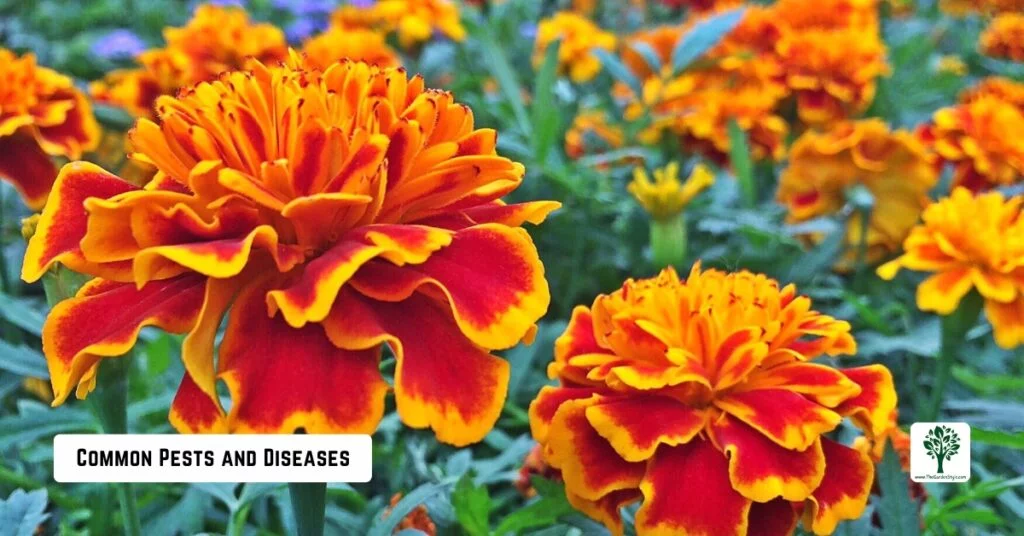
Marigolds are relatively pest-resistant but may occasionally attract aphids, spider mites, or caterpillars. Monitor your plants regularly and treat any infestations promptly with organic insecticidal soap or neem oil. Learn how to mix neem oil for plants.
Prevent fungal diseases such as powdery mildew by ensuring good air circulation around your marigolds. Avoid overhead watering, as wet foliage can promote the growth of fungal pathogens.
Uses of Marigolds
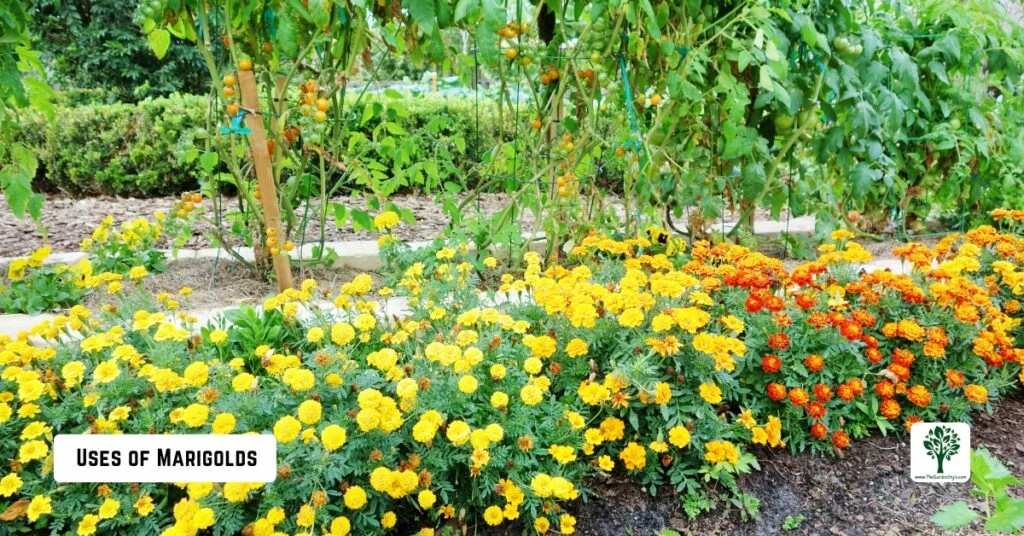
Marigolds are not only beautiful in the garden but also have various practical uses:
- Cut Flowers: Their vibrant blooms make lovely cut flower arrangements and can be dried for long-lasting decorations.
- Companion Planting: Marigolds are believed to deter certain pests, such as nematodes, and can be planted alongside vegetables and other crops.
- Culinary Uses: The edible petals of some marigold varieties can be used to add color and flavor to salads, garnishes, and other dishes.
- Natural Dye: Marigold petals can also be used to create natural dyes for fabric, yarn, or even cosmetics. The vibrant yellow, orange, and red hues can produce beautiful, rich colors.
- Skin Care: Some skin care products contain marigold extracts, which are thought to have soothing and healing properties for various skin conditions.
Recommend reading: How to Start a Cut Flower Garden: Plan and Layout
Using Marigolds as Companion Plants
Marigolds, with their vibrant hues and natural pest-repelling properties, serve as excellent companions in the garden. Incorporating marigolds into your planting scheme not only adds a pop of color but also provides numerous benefits to neighboring plants. Here’s how you can maximize the potential of marigolds as companion plants:
- Pest Repellent: Marigolds emit a scent that repels many common garden pests, including nematodes, aphids, whiteflies, and even mosquitoes. By interplanting marigolds with susceptible crops, you can help deter pests without resorting to chemical pesticides.
- Nematode Control: Nematodes are microscopic worms that can wreak havoc on plant roots, leading to stunted growth and decreased yields. Marigolds produce compounds that suppress nematode populations in the soil, making them particularly beneficial when planted alongside susceptible crops like tomatoes, peppers, and potatoes.
- Soil Improvement: Marigold roots exude substances that inhibit the growth of harmful soil-borne pathogens, promoting a healthier root environment for neighboring plants. Their fibrous root system also helps to loosen compacted soil, improving drainage and aeration.
- Attracting Pollinators: While marigolds are not major attractors of pollinators for vegetable crops, they do attract bees and butterflies, contributing to overall garden biodiversity. A diverse range of pollinators can enhance fruit set and ensure bountiful harvests.
When using marigolds as companion plants, consider planting them strategically throughout the garden, especially in areas prone to pest infestations or soil-borne diseases. Choose varieties with strong pest-repelling properties, such as Tagetes erecta (African marigold) or Tagetes patula (French marigold), and intersperse them with your favorite vegetables and herbs.
Final Conclusions
Growing marigolds is a rewarding experience for gardeners of all skill levels. These vibrant annuals are not only a feast for the eyes but also offer practical benefits as companion plants, natural dyes, and even culinary additions. By following the simple steps outlined in this guide, from choosing the right variety and planting at the appropriate time to providing proper care through watering, fertilizing, and grooming, you can enjoy a stunning display of marigold blooms throughout the growing season. Whether planted in borders, containers, or mixed with other flowers and vegetables, marigolds are a low-maintenance yet high-impact addition to any garden.
Frequently Asked Questions
Marigolds can indeed thrive indoors as long as they receive sufficient sunlight. Place them near a sunny window or provide supplemental grow lights for best results.
While marigolds prefer full sun, they can tolerate some light shade. However, for optimal growth and blooming, it’s best to plant them in a location that receives at least 6-8 hours of direct sunlight per day.
Yes, marigolds are sun-loving plants and perform best when grown in full sun. Ensure they receive ample sunlight to promote healthy growth and abundant flowering.
Marigold heights can vary depending on the variety, but most common types range from 5 to 18 inches tall. Compact varieties like French marigolds typically stay on the shorter side, while African marigolds can reach taller heights.
If this post about how to grow marigolds was helpful, please share it:
